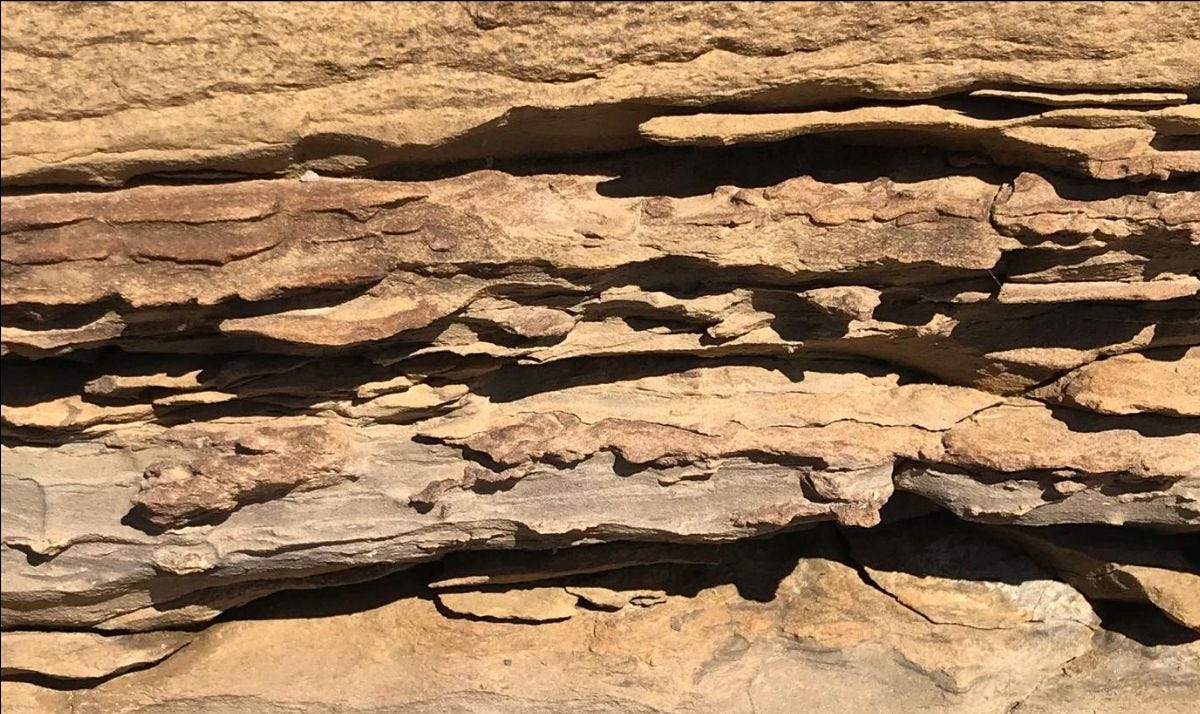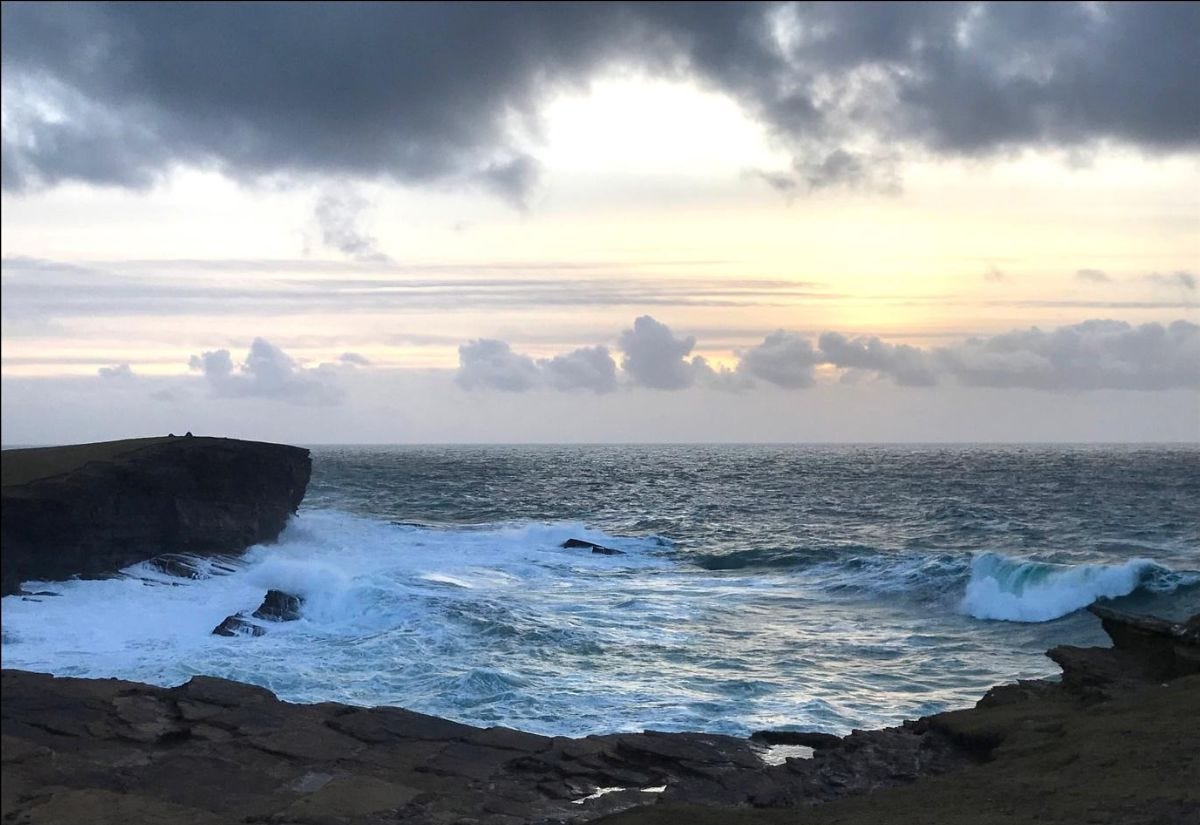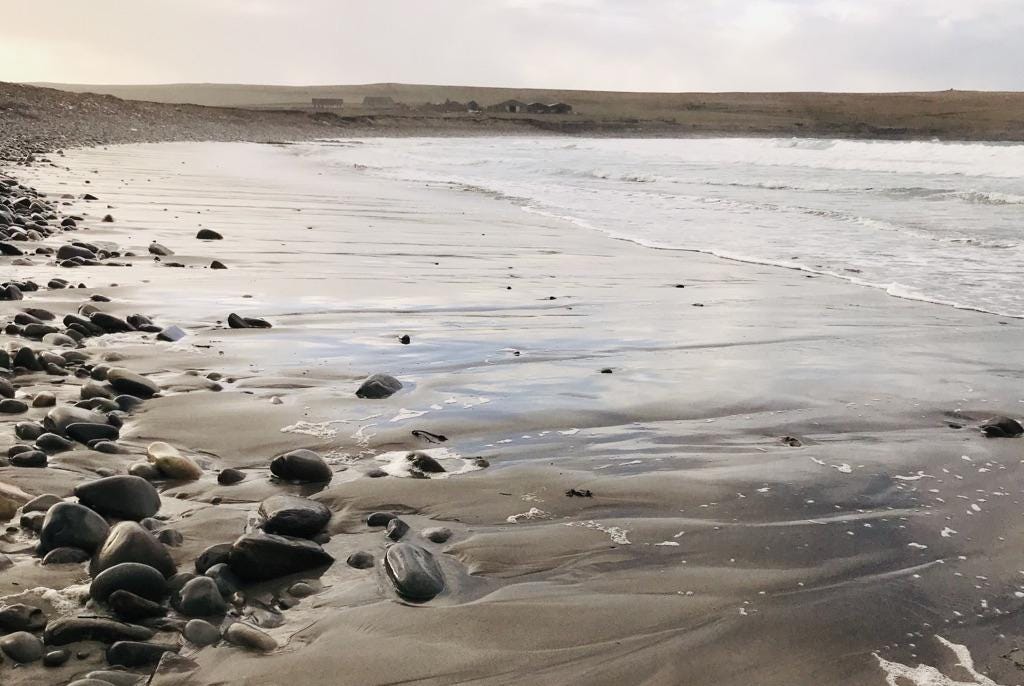In last week’s newsletter, I shared with you a conversation I had with archaeologist Mark Edmonds, as together we pondered a flint handaxe that Mark had written about in his book and brought to my studio.
It’s a perfect teardrop shape, but with a twist to it, so it fits the hand ergonomically. There is such a ‘rightness’ to its form. Like a seedpod, a leaf bud, a boat.
We talked about how the piece of flint from which the handaxe was made was itself formed in the ocean of the Cretaceous period, from the remains of marine organisms that accumulated on the ancient seabed. And we noticed how, when you look into the glassy surface of the worked flint, it’s like looking into the green-grey sea, rippled with waves.
TIME IS WEIRDER THAN WE THINK
The flint handaxe it drops vertically through time like a plumb line. It brings into question the difference we normally perceive between then and now, between them and us, between animal and mineral, between living organism and inert matter. It’s a startling sensation, one that Mark described as being like vertigo. This object, shaped by our ancestors nearly half a million years ago, from flint formed when dinosaurs still walked the land, brings into question our habitual ways of thinking about time.
The handaxe is a reminder that time is a lot weirder than we tend to think.
But really, objects like the handaxe are not rare at all. It’s just that we don’t notice them.
Every morning I walk to my studio over a cracked flagstone that clearly shows the ripples of a tide that passed over a shallow tropical sea 400 million years ago. I write this letter using words whose roots thread into the deep linguistic Indo-European past, whose sounds have been shaped by millions of tongues. I live in a house whose name links to a Norse history a thousand years deep, even if the building itself dates back only a couple of hundred.
Yesterday, with Spring days lengthening out and the growing season under way, I pushed seeds into trays of compost, heritage seeds that have been carefully passed on from grower to grower, season after season, generation after generation, for hundreds, perhaps even thousands of years. And, a mile off, the tide was answering the pull of the moon’s orbit, just as it has done twice a day for billions of years.
So many timescales intersect and overlap, and we're involved in all of them.
As I hoed out the weed seeds that are rapidly germinating among my garlic shoots now the soil is warming, I heard curlew calling overhead, as they have each spring since the ice last receded 10,000 years ago.
Each time I hear a curlew calling I feel a sense of relief, mixed with a foretaste of grief. The Curlew is one of our most rapidly declining breeding bird species showing a 46% decline across the UK from 1994-2010 with this figure exceeding 50% in Wales and Scotland. I fear that the curlew, and so much else, will soon be lost in a spiral of accelerating climate change and rampant extractionist Capitalism.
If glimpsing the deep past offers up a mix of both vertigo and a reassuring sense of continuity, a glimpse of the future offers something darker. Often, it feels like urgency, a sense of time running out as the Doomsday clock ticks ever closer to midnight. Sometimes, generally at about 3am, it feels like dread.
In the prologue Jenny Odell’s new book “Saving Time: Discovering a Life Beyond the Clock” the author explains that it was this sense of dread, and the associated urgency that can so easily flip into nihilism and apathy, that prompted her to think more deeply about time, and to write in the hope of offering “a future shelter for any reader who feels the same heartbreak as I.”
Count me in.
Jenny Odell, “Saving Time: Discovering a Life Beyond the Clock”
“This book grew out of my feeling that a significant part of climate nihilism and other painful experiences of time comes from an inability to recognise or access that fundamental uncertainty that lives at the heart of every single moment, where our agency also lives.”
“Initially I set out to try and find a conception of time that wasn’t painful – something other than time as money, climate dread or fear of dying. It was more of a personal question than an academic one. In my search, I found something I didn’t expect: that while one temporal sense can make you feel dead before your time, a different one can make you feel undeniably alive.”
Drawing from thinkers like Hannah Arendt, Henri Bergson, Ivan Illich and Karl Marx, as well as a range of indigenous thinkers, Odell examines how we got to the point where time equals money, and both feel like increasingly scant resources. She reminds us that other cultures have a more nuanced and sophisticated conception of time. Indeed, she points out, our own culture once had access to a broader set of conceptual tools to understand time.
CHRONOS AND KAIROS
The ancient Greeks had two words for time. Chronos was linear time, the time of the clock, time that passes. Kairos, on the other hand, was time in the sense of timeliness, the ‘right’ time, time of crisis, time as ‘ripe’.
If Chronos is time as a river, Kairos is time as wetness, as fog, rain, clouds, time that seeps, collects in aquifers. Time as depth.
Rock Strata at Yesnaby
Odell points out that thinking differently about time has real implications:
“The difference between perceiving chronos and perceiving kairos may begin in the conceptual realm, but it doesn’t end there: it directly affects what seems possible in every moment of your life”
The colonisation of time by Capital, Odell observes “also affects whether we see the world and its inhabitants as living or dead-alive. This is perhaps the most far-reaching consequence of the idea that (European) Man is the sole mover and shaker in a natural world that lives by predictable, mechanistic laws. When it emerged, this distinction relegated colonised people to a kind of permanent stasis within Chronos, the same agency-less category as their lands and all the other life within them. The conception not only justified colonists’ exploitation of these ‘resources’ but also set the stage for both the climate crisis and the racial injustices of today. To (re)learn to see action and decision outside such a narrow realm – to admit that everything and everyone previously left out of the picture is equally real, in Kairos together – is to see time not as happening to objects in the world but as being co-created with the actors of the world. To me, this is an issue both of justice and of practicality, as I read the climate crisis as an issue of justice and of practicality”.
This temporal sense is, she argues, accessible to all of us.
“To watch a sunrise…is to understand that while the sun rises every day, no individual sunrise will ever happen again. Each one gives us an image of renewal, return, creation, and a ’new day’ and fleetingly repairs that Western rift between time and space.”
Sunset at high tide, Brough of Bigging
We might not all have ready access to a 400,000 year old flint handaxe to open us up to sensing time as layered and generative, but we all have access to a sunrise, to tides, the leaves just now erupting from the end of every bare twig, even our own faces or those of our children, that bear the visible trace of our grandparents.
Odell recounts her own experience of visiting a rocky foreshore:
“Suddenly, everything we look at is suffused with concrete time: not just the pebbles, crags and cliffs, but also to fog’s slow movement to the South, each wave’s unrepeatable expression of tides and wind, the frenetic activities of the beach flies, the dispersion of air and water through our bodies, and even the chemicals flashing across our synapses as we think these very thoughts. They, too, will never repeat and they, too, make the world anew.”
TIME AS UNPREDICTABILITY AND POTENTIAL
Thinking of time as a clock that is steadily running down to midnight reduces our sense of agency and possibility. If Doomsday is just ninety seconds off, the intervening moments between ‘now’ and ‘then’ become a void ‘meantime’ that we might as well just get over with. But, Odell argues:
“We can choose to believe that time is the site of unpredictability and potential rather than inevitability and helplessness…In that sense, changing how we think about time is more than a means for confronting personal despair in a catastrophic meantime. It can also be a call to action in a world whose current state can’t be taken for granted.”
Beach at Skaill with Skara Brae Neolithic settlement in the background
The resolution Odell reaches isn't a simple happy ending, but something embodied and enmeshed with the ongoingness of the world.
As she stands on the rocky shore, at the close of this exploration of time, she notices that what she feels isn’t exactly joy, nor is it despair, but
“something tidal. An oscillation back and forth, impossible to pin down and yet possibly legible to those around me: the ducks, who would migrate again, to the trees, which would turn green again, to the mussels who would be submerged again, to the water, which would flow back out again. Not did my body misunderstand, In the centre of me a muscle was beating, a series of creation events ongoing for now that I hadn’t started and wouldn’t stop. Under the rush of the water, I felt my heartbeats as words. They were saying what they had always said. Again. Again. Again.”
May you find time this week, among the hurry of life in Chronos, to also find time in Kairos.
Sam










